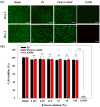Robust Copper Metal-Organic Framework-Embedded Polysiloxanes for Biomedical Applications: Its Antibacterial Effects on MRSA and In Vitro Cytotoxicity
- PMID: 33809285
- PMCID: PMC8000151
- DOI: 10.3390/nano11030719
Robust Copper Metal-Organic Framework-Embedded Polysiloxanes for Biomedical Applications: Its Antibacterial Effects on MRSA and In Vitro Cytotoxicity
Abstract
Polysiloxanes (PSs) have been widely utilized in the industry as lubricants, varnishes, paints, release agents, adhesives, and insulators. In addition, their applications have been expanded to include the development of new biomedical materials. To modify PS for application in therapeutic purposes, a flexible antibacterial Cu-MOF (metal-organic framework) consisting of glutarate and 1,2-bis(4-pyridyl)ethane ligands was embedded in PS via a hydrosilylation reaction of vinyl-terminated and H-terminated PSs at 25 °C. The bactericidal activities of the resulting Cu-MOF-embedded PS (PS@Cu-MOF) and the control polymer (PS) were tested against Escherichia coli, Staphylococcus aureus, and methicillin-resistant Staphylococcus aureus. PS@Cu-MOF exhibited more than 80% bactericidal activity toward the tested bacteria at a concentration of 100 μg⋅mL-1 and exhibited a negligible cytotoxicity toward mouse embryonic fibroblasts at the same concentration. Release tests of the Cu(II) ion showed PS@Cu-MOF to be particularly stable in a phosphate-buffered saline solution. Furthermore, its physical and thermal properties, including the phase transition, rheological measurements, swelling ratio, and thermogravimetric profile loss, were similar to those of the control polymer. Moreover, the low cytotoxicity and bactericidal activities of PS@Cu-MOF render it a promising candidate for use in medicinal applications, such as in implants, skin-disease treatment, wound healing, and drug delivery.
Keywords: Cu-MOF; antibacterial agent; biomedical application; cytocompatibility; hydrosilylation; polysiloxane (PS).
Conflict of interest statement
The authors declare no conflict of interest.
Figures







Similar articles
-
Novel Metal-Organic Framework-Based Photocrosslinked Hydrogel System for Efficient Antibacterial Applications.ACS Appl Mater Interfaces. 2020 May 6;12(18):20234-20242. doi: 10.1021/acsami.0c03187. Epub 2020 Apr 24. ACS Appl Mater Interfaces. 2020. PMID: 32285658
-
Polyurethane Foam Incorporated with Nanosized Copper-Based Metal-Organic Framework: Its Antibacterial Properties and Biocompatibility.Int J Mol Sci. 2021 Dec 19;22(24):13622. doi: 10.3390/ijms222413622. Int J Mol Sci. 2021. PMID: 34948419 Free PMC article.
-
A flexible fibrous membrane based on copper(II) metal-organic framework/poly(lactic acid) composites with superior antibacterial performance.Biomater Sci. 2021 May 18;9(10):3851-3859. doi: 10.1039/d1bm00164g. Biomater Sci. 2021. PMID: 33890581
-
Roles and current applications of S-nitrosoglutathione in anti-infective biomaterials.Mater Today Bio. 2022 Sep 6;16:100419. doi: 10.1016/j.mtbio.2022.100419. eCollection 2022 Dec. Mater Today Bio. 2022. PMID: 36105674 Free PMC article. Review.
-
Surface ligand-assisted synthesis and biomedical applications of metal-organic framework nanocomposites.Nanoscale. 2023 Jun 30;15(25):10529-10557. doi: 10.1039/d3nr01723k. Nanoscale. 2023. PMID: 37323021 Review.
Cited by
-
A Nanostructured Cu(II) Coordination Polymer Based on Alanine as a Trifunctional Mimic Enzyme and Efficient Composite in the Detection of Sphingobacteria.Bioinorg Chem Appl. 2022 Apr 11;2022:8788221. doi: 10.1155/2022/8788221. eCollection 2022. Bioinorg Chem Appl. 2022. PMID: 35449715 Free PMC article.
-
Bimetal-Organic Framework-Loaded PVA/Chitosan Composite Hydrogel with Interfacial Antibacterial and Adhesive Hemostatic Features for Wound Dressings.Polymers (Basel). 2023 Nov 9;15(22):4362. doi: 10.3390/polym15224362. Polymers (Basel). 2023. PMID: 38006086 Free PMC article.
-
Nickel Nanoparticles: Applications and Antimicrobial Role against Methicillin-Resistant Staphylococcus aureus Infections.Antibiotics (Basel). 2022 Sep 7;11(9):1208. doi: 10.3390/antibiotics11091208. Antibiotics (Basel). 2022. PMID: 36139986 Free PMC article. Review.
-
Biomimetic Antibacterial Pro-Osteogenic Cu-Sericin MOFs for Osteomyelitis Treatment.Biomimetics (Basel). 2022 May 20;7(2):64. doi: 10.3390/biomimetics7020064. Biomimetics (Basel). 2022. PMID: 35645191 Free PMC article.
-
Synthesis of Ribose-Coated Copper-Based Metal-Organic Framework for Enhanced Antibacterial Potential of Chloramphenicol against Multi-Drug Resistant Bacteria.Antibiotics (Basel). 2021 Nov 29;10(12):1469. doi: 10.3390/antibiotics10121469. Antibiotics (Basel). 2021. PMID: 34943681 Free PMC article.
References
Grants and funding
LinkOut - more resources
Full Text Sources
Other Literature Sources
Molecular Biology Databases
Miscellaneous

